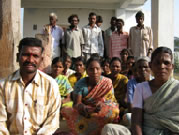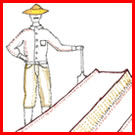Diversifying livelihoods may be a good option for increasing resilience in the face of climate change challenges. There are many micro-lending and micro-enterprise programs in the developing world able to assist. However, not everyone is an entrepreneur. Another challenge is that frequently people think of a product they can sell, begin making it, and have trouble finding customers. There are several simple things can be done to address these challenges.
| One | |
 |
The first step is to form an association of community members for the purpose diversifying livelihoods and finding alternative forms of income generation. An association can give direction, consistency, management and a single point of contact for a buyer. These services can be a benefit to association members who are not individually entrepreneurial. |
The first step in forming an association is to introduce the concept in a participatory workshop setting. Frequently communities are made up of groups of people pursuing similar activities. For example, there might be groups of weavers, artisans or farmers. Ask your community contacts to approach one of these groups of community members about participating in a consciousness-raising workshop on alternate sources of income. In the workshop you can begin by introducing the rationale and importance of having an income generation association with its own management committee—and what benefits it could offer association members. In the beginning, the association does not need to be a formal, legal entity.
In this introductory workshop, ask if there are members who would be interested in sitting on the association management committee. Discuss the types of skills that will need to be developed by committee members. Suggest appointing an interim committee who over the course of six months could develop the ultimate committee structure, establish committee member responsibilities, ensure gender inclusiveness, set goals, and establish a plan. Have an open discussion with the workshop participants to set a number of people that should serve on the committee—and then ask for volunteers for the interim committee.
Two.
Conduct a survey of businesses in the region that buy products in their type of work on a routine basis. Pick businesses that are purchasing products which are appropriate for your level of production capability. Ask them what products are they most in need of. Ask if they would have interest in forming a market link with the association. Ask if they would be willing to partner in developing a training program so that the association members will be able to produce to their quality expectation.
An example could be an association of smallholder farmers who through these surveys discovers a buyer who needs more cucumbers for their wholesale markets in the city—and for export. Frequently buyers such as these, since they need additional product, will make an investment in farmer training and a micro-loan of seeds for planting. These agricultural produce buyers frequently have extension agents which provide follow-up to the farmers. They also would prefer to work with a single association contact rather than work with 20 individual farmers.
But don’t overlook other potential markets. Perhaps the market in the next big city has vendors which need products every week. Perhaps there are products that are in short supply that your association could sell themselves from a market stall. Before beginning production however, make certain that there is a market. Your NGO might have individual donors with connections or board members with business experience who can help develop a strategy or make introductions.
Search and Rescue Training
Search and rescue team members learn specific techniques that are safe, and are given simple tools such as lifejackets, safe boats, inner tubes, and flashlights which give them the confidence and the capability to look for a missing person or of rescuing a trapped, elderly or disabled person.
Three.
Once you have identified an actual market for a product or service and solidified a relationship, you might need training in delivering that product or service. Solicit assistance from the buyer for the training, your local government, the central government—or perhaps an NGO for delivering the training.
Four.
Before beginning production you should have a clear definition of the product’s value, its seasonality, the quantities that the buyer is intending to purchase, and the costs and time investment for producing the product. It might be a good idea to ask someone with bookkeeping skills to lay this out in a simplified presentation. This way, you can determine how much money association members could make through the sales of this product. You might also find that sales levels limit the number of people that can belong to the association.
Five.
Get training for the association committee. They will need to know basic bookkeeping skills, basic management skills and organizational skills. If they are the contact point for the buyer they will also need to learn basic negotiation skills.
Six.
Try and organize the trainings to coincide with production. In other words, using the theme of the farmers above, if they’re going to receive training on field preparation and planting of cucumbers for the buyer, try to organize the training so that they are planting something that they will actually be able to sell to the buyer. Frequently the extension agents of large produce buyers are willing to provide startup and incremental training for producers throughout the course of the season.
Copyright © 2012, Tim Magee

